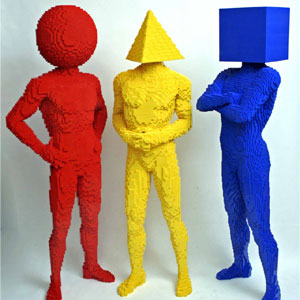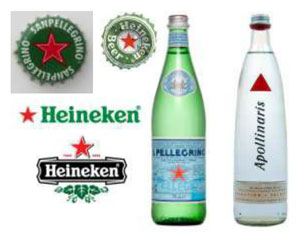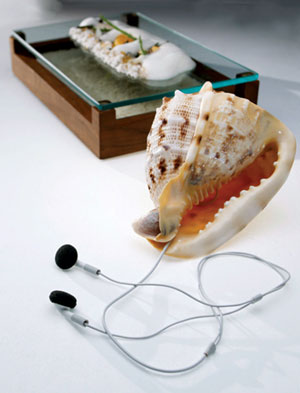Did You Know That Shapes Can Have an Impact on Flavor?
Yes! Shapes act as symbols that influence our choice and may affect our perception of flavor. Why? Because they subconsciously represent that which we desire, that which we hedonically select for the mere sake of pleasure! This marvelous mechanism of our mind is called oral somatosensation… actually meaning I INTUITIVELY CHOOSE WHAT GIVES ME PLEASURE! Well… aren’t we smart? But we are not the only smart ones. Because food and beverage companies make use of this mechanism that we consumers apply!
These concepts and much more, are the result of an important and thorough research carried out by Charles Spence (left picture) – head of the Crossmodal Research Laboratory at Oxford University, United Kingdom – and Mary  Kim Ngo. Spence has been working together with molecular gastronomy Chef Heston Blumenthal for years and his research results have led to the introduction of new dishes such as the signature seafood dish ‘Sound of the Sea’ on the tasting menu of The Fat Duck restaurant. You can read more about Charles Spence’s and Heston Blumenthal’s Multisensory Perception work starting on page 484 of “The Fat Duck Cookbook”.
Kim Ngo. Spence has been working together with molecular gastronomy Chef Heston Blumenthal for years and his research results have led to the introduction of new dishes such as the signature seafood dish ‘Sound of the Sea’ on the tasting menu of The Fat Duck restaurant. You can read more about Charles Spence’s and Heston Blumenthal’s Multisensory Perception work starting on page 484 of “The Fat Duck Cookbook”.
It is quite impressive to observe how consumers match a variety of tastes (like bitterness, sweetness, and sourness), oral attributes (such as bubbles, oral texture, mouth-feel) and flavors to a great number of abstract shapes. We can name examples: typically, the rounded forms (e.g.circles) are associated with sweet tastes whereas more angular shapes (like triangles and stars) with bitter and/or carbonated foods and beverages.
It will be interesting to see how the shapes of foods, plates and cutlery will be used creatively in molecular gastronomy to influence the eating experience and trick our minds. There is already some evidence of the effect of plate shapes on taste. A study conducted at Oxford University in collaboration with Jamie Ward and others found that presenting an item of food on a round vs. star-shaped plate had a small but significant effect on perceived bitterness.
Shape Symbols to Set Consumer Expectations in the Beverage and Food Market
 Manufactures of food and beverages know that if they apply the right shapes on packaging and presentation, sales volumes will go up! They understand that when shapes, designs, colors and even words and aromas satisfy our sensorial expectations on taste and flavor, they are then doing a great job for the company because their sales grow.
Manufactures of food and beverages know that if they apply the right shapes on packaging and presentation, sales volumes will go up! They understand that when shapes, designs, colors and even words and aromas satisfy our sensorial expectations on taste and flavor, they are then doing a great job for the company because their sales grow.
The shapes and colors consumers see on labels, the shape of food and beverage packaging, the plates on which the products are served and even the form in which the food itself is presented have a strong impact on the response of consumers who subconsciously make hedonic choices when it comes to taste/flavor choices.
It was previously suggested that the colors and shapes of product packaging can be just as important, if not more, than any text/descriptions, in terms of setting-up expectations (whether consciously or otherwise) about a product’s likely sensory qualities specially on account of the little attention consumers give to some labels (e.g., back labels on wine bottles).
The theory here is that under the majority of conditions (molecular gastronomy restaurants excepted) consumers tend to prefer products if their taste, aroma, flavor, and/or oral attributes match their sensory expectations.
Shape…. Plus Color and Sound!
Color also intervenes in these so called “somatosensation” mechanisms. Given this fact (that consumers associate colors with basic tastes - e.g., red with sweetness) it is presumably no coincidence that the logo of 7-Up happens to contain a prominent red circle smack in the middle of the logo. Researcher Cheskin is known to have worked on this packaging.
 What better way after all to connote the sweetness of the drink itself, and why not think that the lemon/lime flavor of the beverage is presumably signified by the predominant green coloring of the rest of the packaging? What can we then say about color correspondences? It is that “match” between certain colors of food and drinks with tastes/flavors. For example, strawberry is usually pinkish.
What better way after all to connote the sweetness of the drink itself, and why not think that the lemon/lime flavor of the beverage is presumably signified by the predominant green coloring of the rest of the packaging? What can we then say about color correspondences? It is that “match” between certain colors of food and drinks with tastes/flavors. For example, strawberry is usually pinkish.
Similarly, a number of other beverage products appear to use angular red shapes, frequently a star, sometimes a triangle or pyramid, in order to sub-consciously signal to the consumer that the contents of the packaging are carbonated (and/or bitter-tasting).
For example, Heineken Beer and Pellegrino’s sparkling mineral  water both have red stars in the packaging. This latter product is an example of highly successful product packaging design for more than a century now.
water both have red stars in the packaging. This latter product is an example of highly successful product packaging design for more than a century now.
How has color been used in molecular gastronomy? At The Fat Duck, Heston Blumenthal plays with color in his “Orange Jelly” dish to make diners believe a purple-colored jelly is beetroot and an orange is orange when in fact the reverse is true.
In addition to shape and color, sound has a dramatic effect on our perception of food. For example, Spence has established that people’s perception of crispiness and freshness of potato chips can be systematically altered by varying what they hear when they bite into them. This is why Kellogg tried to trademark the crackling sound made by Corn Flakes!
Researchers have also found reliable associations between taste perception and music. You can read more about this research and listen to some examples in our post “Music That Can Generate The Taste Association of Sour, Bitter, Sweet and Salty”. Heston Blumenthal’s “Sound of the Sea” dish is an excellent example of a good use of sound to influence the diner’s eating experience.
Conclusions of Shape Symbolism Research
In the last couple of years the understanding of - and evidence for - correspondences between shapes (not to mention sounds and colors) and tastes/flavors grew remarkably.
Although upon a visual inspection of the products presently in the market it seems that the majority follow the Shape-Symbolism theory in order to obtain from the consumers their hedonic approval, it is yet hard to say if this merely is the “survival of the fittest”.
However, the research clearly reviews how widely reliable and easy to assess such correspondences are. The effects also appear to be fairly sound, considering that very similar results were obtained when the same food was assessed through different studies. Most likely, certain shape symbols reported could be considered universal though further research will be needed on the topic to reveal the sensory expectations that give way to hedonic results in other cultures.
The latest evidence now supports that the expectations set up by shape (color or sounds present in the brand name) can influence people’s product perception. Thus, Shape Symbolism to picture flavor, taste and other attributes are a must to answer consumer expectations of satisfaction.





